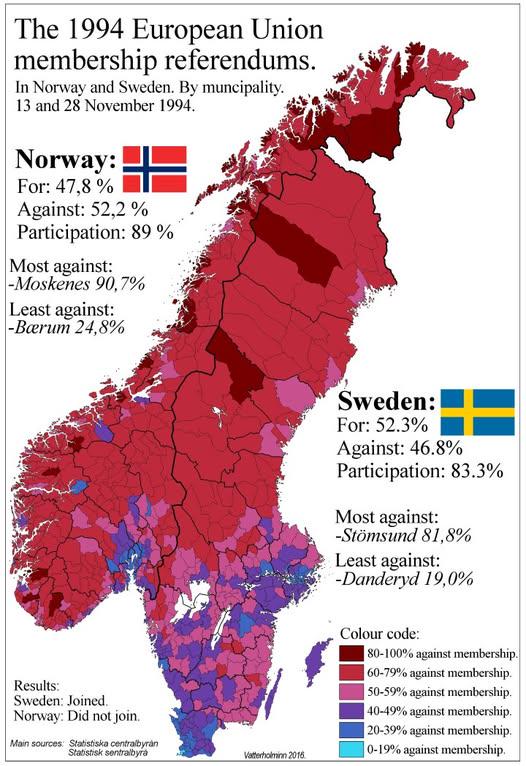1994 Swedish and Norwegian EU Referendum Results Map


David Chen
Data Visualization Specialist
David Chen is an expert in transforming complex geographic datasets into compelling visual narratives. He combines his background in computer science ...
Geographic Analysis
What This Map Shows
The "1994 Swedish and Norwegian EU Referendum Results By Municipality" map presents a detailed view of how different municipalities in Sweden and Norway voted in the pivotal referendums regarding European Union membership. In 1994, both countries held votes that would shape their future relationship with the EU, making this map a significant historical document. The visualization clearly indicates areas of overwhelming support for EU membership and pockets of strong opposition, allowing us to analyze regional sentiments in both nations.
Deep Dive into EU Referendums in Sweden and Norway
The referendums held in Sweden and Norway in 1994 were critical moments in the European integration process. Sweden’s decision to join the EU was ultimately affirmed with a 52.3% majority in favor, while Norway saw a narrow defeat for membership, with 52.2% voting against. These outcomes reflected not only national sentiments but also deep-seated regional attitudes shaped by historical, economic, and cultural factors.
Interestingly, the Swedish municipalities that voted in favor of EU membership were often urban centers, reflecting perhaps a more global outlook among their populations. Cities like Stockholm and Gothenburg leaned heavily toward a pro-EU stance, seeing the union as an opportunity for economic growth and increased international cooperation. On the other hand, rural areas, particularly in northern Sweden, showed significant resistance. Here, concerns about local autonomy, agricultural policies, and fears of losing cultural identity played a substantial role in shaping voter opinions.
Norway's results, while similarly divided, tell a different story. The country has a long history of skepticism toward EU membership, rooted in its strong sense of national identity and independence. The anti-EU sentiment was particularly strong in rural regions and among those reliant on industries such as fishing and agriculture, which feared that EU regulations would undermine their livelihoods. Areas like Finnmark and parts of Trøndelag were staunchly opposed, showcasing a consistent pattern of resistance across several referendums in Norway's history.
What’s fascinating is how the economic implications of EU membership were often at the forefront of voters' minds. In Sweden, proponents argued that joining the EU would unlock new markets and opportunities, enhancing the country's robust welfare system. Conversely, opponents were concerned about the potential loss of agricultural subsidies and the impact of EU regulations on Sweden’s social welfare model. In Norway, the resistance was more deeply rooted in a desire to maintain control over natural resources, particularly in the fishing sector, which is vital for local economies.
Regional Analysis
Analyzing the map at a regional level reveals a tapestry of attitudes toward EU membership. For instance, in Sweden, the northern municipalities of Norrbotten and Västerbotten exhibited notable resistance, with many voters worried about the implications of EU agricultural policies on their farming practices. Conversely, the southern regions, including Skåne, generally supported EU membership, highlighting the economic advantages perceived by urban populations.
In Norway, the divide was even more pronounced. The southeastern and central regions, including Oslo and Akershus, were pro-EU, while areas like Nordland and Møre og Romsdal remained skeptical. This divide raises questions about how economic priorities and cultural identities influence political decisions. Interestingly, the map illustrates how historical ties to certain industries, such as fishing and agriculture, shaped regional identities and voting patterns.
Significance and Impact
The outcomes of the 1994 referendums in Sweden and Norway had far-reaching implications, not just for the countries involved but for the broader European context as well. Sweden's decision to join the EU has since aligned it more closely with European policies and markets, facilitating economic growth and increased cooperation. However, this has also led to ongoing debates about national sovereignty and the extent of EU influence in domestic affairs.
Norway’s rejection of EU membership has allowed it to maintain a unique relationship with the EU through the European Economic Area (EEA), providing access to the single market while retaining control over certain key areas like fisheries. This model has sparked discussions about the balance between integration and independence, an ongoing theme in European politics.
As we look toward the future, the regional divides illuminated by this map can help us understand current trends in nationalist sentiments across Europe. With rising skepticism toward the EU in various member states, the historical context provided by the 1994 referendums remains relevant. The question persists: how will local identities and economic realities continue to shape the political landscape in Northern Europe? The map serves as a reminder that geography and regional attitudes play a crucial role in shaping the future of political unions like the EU.
Visualization Details
- Published
- August 9, 2025
- Views
- 100
Comments
Loading comments...